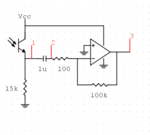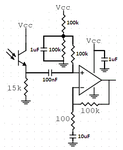Tricka90
Member level 1
I'm trying to amplify a 1kHz square wave signal sent from a IR LED with a IR phototransistor and an Op-Amp (LM358).
I made up with this scheme but it doesn't work:

On point 1 I read a DC component plus the frequency which becomes bigger in amplitude as I approach the IR LED that transmits it.
On point 2 I only have the frequency.
It's all good for now. So I try to amplify this frequency by using tha Op Amp in Inverting Voltage Amplifing mode.
So Vout should be: ( -R2/R1 ) x Vin.
But it just doesn't work. The Vout is just too little, even less than Vin.
The all circuit is powered with 15V (not dual).
What am I doing wrong?
I made up with this scheme but it doesn't work:

On point 1 I read a DC component plus the frequency which becomes bigger in amplitude as I approach the IR LED that transmits it.
On point 2 I only have the frequency.
It's all good for now. So I try to amplify this frequency by using tha Op Amp in Inverting Voltage Amplifing mode.
So Vout should be: ( -R2/R1 ) x Vin.
But it just doesn't work. The Vout is just too little, even less than Vin.
The all circuit is powered with 15V (not dual).
What am I doing wrong?
